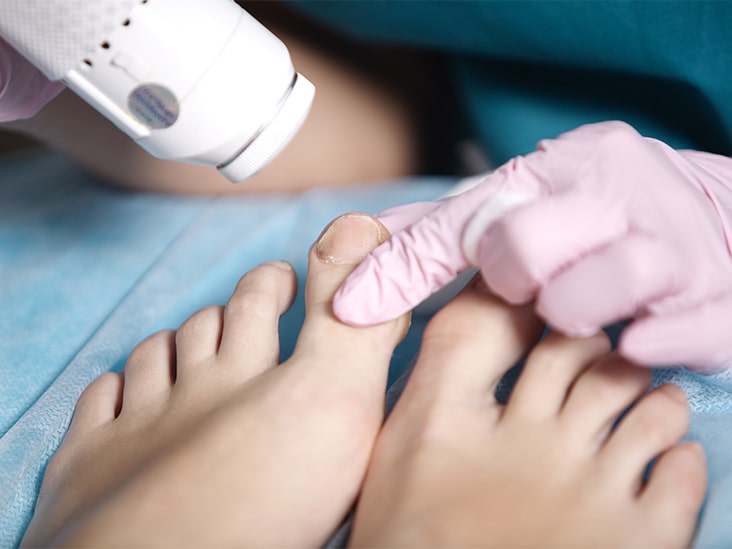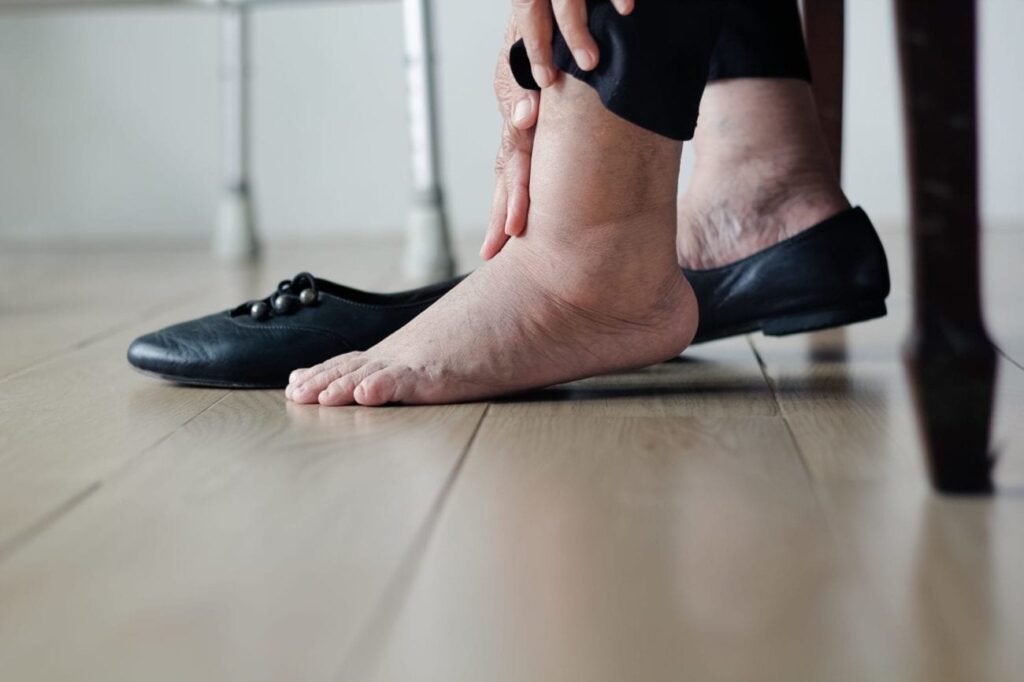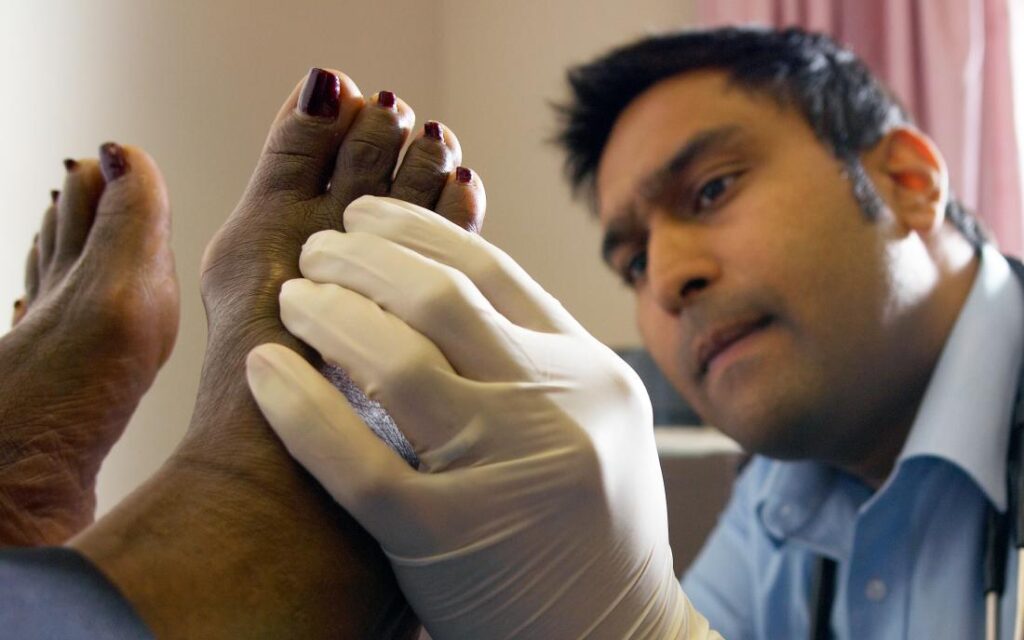FOOT CANCERS
Cancers of the feet and ankle usually go undiagnosed and can be the most deadly until the cancer has spread.
There are various kinds of cancers that develop on the foot such as melanoma, neoplastic disorders, benign or malignant tumors. Melanoma is malignant skin cancer. Benign tumors developing under the toenail such as osteochondromas, can be removed surgically. Additionally, plantar fibroma which is a benign tissue tumor develops in the bottom of the foot.
Different types of skin growths appear similar to anomalies such as warts, eczema, and fungal or bacterial infections. It is important to get this checked by your foot doctor or podiatrist to make sure they are not malignant.

TYPES OF FOOT CANCER
There are various type of foot cancer that include:
- Basal cell carcinoma: This is observed as sun-exposed skin surfaces. Your feet are significantly less exposed to the sun making it less common form of foot cancer. It usually does not spread beyond the skin and causes local damage. Basal cell cancers appear as pearly white bumps or patches and might ooze or crust looking like an open sore. Appearing on the skin of the lower legs and feet, basal cell cancers are similar to non-cancerous skin tumors or benign ulcers. These are not as potentially deadly as melanoma. These rarely spread far beyond their initial place that they initially appeared. The lesions look like small open cuts or shiny lumps and appear on the surface. This cancer can cause localized problems when not treated early enough, even though this cancer isn’t very aggressive.
- Malignant Melanoma: Considered as the most deadly of cancers. It usually has a limited surface area, but continues to grow inward. Thus, it can go undetected and spread to other parts of the body. Malignant melanoma develops underneath the toenails and it can be very difficult to identify. Its appearance is similar to moles, blood blisters, and other skin conditions. Non-surgical treatments are not very effective, and many remain experimental. You should not ignore the skin abrasions as this type of skin cancer should be detected very early to ensure your survival. These occur on the skin of the feet, both on the soles and on the top of the feet as well as beneath a toenail. The melanoma could become more serious as it grows and extends deeper into the skin and may spread through the body through the lymphatic and blood vessels.
- Squamous Cell Carcinoma: It is the most common form of cancer on the skin of the feet. Early squamous cell carcinoma are limited to the skin and do not spread. But, in an advanced stage these can become more aggressive and spread throughout the body. It usually begins as a small scaly bump or plaque appearing inflamed. It sometimes occurs as recurrent cracking or bleeding beginning as a hard projecting callus-like lesion. These mostly are painless, but might be itchy. These might be similar to a plantar wart, a fungal infection, eczema, an ulcer, or other common skin conditions of the foot.
- Bone Sarcoma: This is a rare type of foot cancer accounting for less than 1 percent of all foot cancers. Non Cancerous bone tumors are much more common than cancerous ones. Most common bone cancer is osteosarcoma, in which the cancerous cells produce bone. Other bone cancers are chondrosarcoma (the cancer cells produce cartilage) and Ewing sarcoma.

CAUSE OF FOOT CANCERS
Similar to melanoma that occurs in other parts of the body, exposure to ultraviolet (UV) rays commonly causes foot melanoma. Exposure to excessive sunlight and tanning bed increases your risk for melanoma. Excessive UV exposure has the capability to turn a noncancerous mole into melanoma. Using sunscreen and protective clothing helps in preventing melanoma when you’re outdoors. But, the feet are often neglected and left exposed to UV rays.
The cause of the bone cancer is unknown. A small number of bone cancers are linked to hereditary factors whereas others are related to previous radiation exposure. Certain rare genetic syndromes passed through families might increase the risk of bone cancer, such as Li-Fraumeni syndrome and hereditary retinoblastoma. Exposure to large doses of radiation given during radiation therapy for cancer increases the risk of bone cancer in the future.

SYMPTOMS OF FOOT CANCER
Sometimes, people with bone sarcoma do not have any changes. Sometimes, the cause of a symptom may be a different medical condition that is not cancer.
People with bone sarcoma usually experience the following symptoms or signs.
- Pain: Pain and swelling that may come and go at first at the site of the tumor. As the stage progresses the pain becomes more severe and steady later. The pain worsens with movement along with swelling in nearby soft tissue.
- Joint swelling and stiffness: A tumor occurs near or in a joint. This causes the joint to swell and become tender or stiff with a limited and painful range of movement.
- Limping: Bone with a tumor breaks, or fractures in a leg usually lead to a pronounced limp. This often occurs in later-stage bone sarcoma.
Rarely, people with bone sarcoma experience fever, feeling unwell, weight loss, and anemia, due to a low level of red blood cells.
The symptoms of melanoma are different from bone cancer. The first sign of melanoma occurs as change in the size, shape, color, or texture of an existing mole as well as development of a new mole. Many people have moles, and most moles are harmless.
But, identifying changes in moles helps in early identification of melanoma. You should check for unusual sores, lumps, blemishes, or markings on the surface of the skin appearing as black or blue-black areas.
You should see a podiatrist immediately if you experience the following:
- Sore that does not heal
- Pigment spreading from the border of a lesion to surrounding skin
- Redness or new swelling spreading beyond the border of a lesion
- Changes in sensation, like itchiness, tenderness, or pain
- Changes observed in the surface of a mole, such as scaling, oozing, bleeding, or the appearance of a bump or nodule

TREATMENT OF FOOT CANCER
The podiatrist would run various tests to confirm the presence of cancer and its stage. Surgery is the main treatment option for most of the foot cancers.
In the early stages, a surgeon would remove the cancerous cells without significantly affecting your daily function or the appearance of your skin. But in case of recurrence of cancerous cells you would need more radical intervention.
Radiation therapy, immunotherapy, and chemotherapy are necessary if the cancer has spread to other parts. Occasionally, a doctor suggests a combination of these to make the treatments more effective.
If the foot cancer does not resolve with treatment the podiatrist along with oncologist would suggest regular immunotherapy, targeted therapy, or other treatments may help keep the cancer in check.
OUTLOOK
The risk of foot cancer is higher in people with longer and more regular exposure to UV light.
The sole of the foot is rarely exposed to sun but taking various precautions may help reduce the risk of foot cancer. It is vital to check your feet regularly, including the nails and the soles. If you experience any skin changes it is necessary to seek medical attention.
If you or anyone you know is suffering from foot problems, our expert providers at Specialty Care Clinics will take care of your health and help you recover.
Call us on (469) 545-9983 to book an appointment with our specialists.
